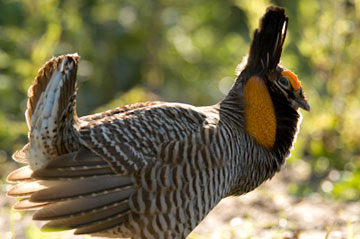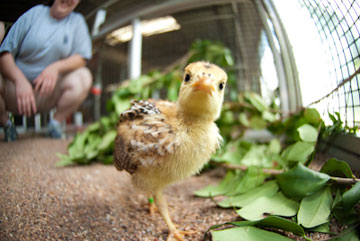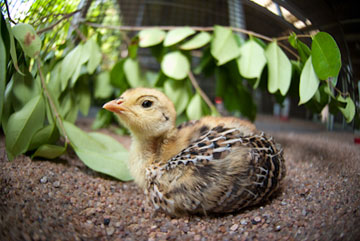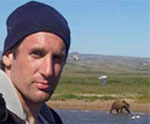Houston Zoo, NASA and a Consortium of Gulf Coast Zoos Race to Save Prairie Chickens
It’s not so complicated, but it’s much easier said than done. I’m referring to the restoration of a species to a habitat that has been transformed over time in the absence of keystone grazing species like bison which served essentially as landscape architects and grounds crew for expansive grassland habitat. In an effort to restore the endangered Attwater’s prairie-chicken (Tympanuchus cupido attwateri) to the coastal prairie ecosystems of Texas and Louisiana, restoration biologists had to find such available and suitable habitat. Less than 100 birds comprise the remaining population at three protected sites – the Attwater Prairie Chicken National Wildlife Refuge,
The Nature Conservancy’s Texas City Prairie Preserve, and private land near Goliad, Texas. Continuing loss of habitat along with predation and invasive vegetation have worked synergistically to decimate Attwater’s prairie chicken in remnant coastal prairie habitat, placing the species on the brink of extinction. An absence of suitable habitat may be the greatest threat to the sustainable recovery of the Attwater’s prairie chickens. Efforts are required to both restore suitable habitat for these birds and release greater numbers of captive-bred birds to populate suitable existing and new habitat. More than a century ago, at least a million of these members of the grouse family, a subspecies of the Greater Prairie Chicken lived on the coastal prairies as the most abundant avian species in the eco-region. With less than one percent of original coastal habitat available, habitat restoration is a clearly a priority, but captive propagation and managing sustainable populations of these gallinaceous birds in breeding facilities are critical to recovery efforts.
 Attwater’s prairie-chicken. Photo by Stephanie Adams, Staff Photographer at the Houston Zoo. |
Thanks to the dedication of the Houston Zoo, the studbook holder and the Species Survival Plan (SSP) coordinator of the captive breeding programs for the Attwater’s Prairie Chicken National Recovery Plan, there is much hope for Attwater’s prairie chicken. The recovery program is overseen by the US Fish and Wildlife Service (USFWS), but through the efforts of the Houston Zoo and their coordination of the SSP, and 5 other zoological partners, a sustainable breeding program has been established for this heavily endangered bird. The 6 zoological partners collaboratively decide which prairie chickens in their collections may breed and subsequently hatch eggs from the clutches produced. The other captive wildlife facilities that participate in the SSP include the following: Abilene Zoo (Abilene, Texas); Caldwell Zoo (Tyler, Texas); Fossil Rim Wildlife Center (Glen Rose, Texas); San Antonio Zoo (San Antonio, Texas); And Sea World Texas (San Antonio, Texas).
The SSP coordinator at the Houston Zoo, Bird Curator Hannah Bailey, determines which birds among captive flocks should breed to maintain the genetic integrity of the captive population, a population which has been selected to augment the wild flocks in the protected areas. In some ways they administer a dating service for poultry, but it’s a very serious responsibility.
 Attwater’s prairie-chicken chick. Photo by Stephanie Adams, Staff Photographer at the Houston Zoo. |
Studbook keepers manage a great number of imperiled species in zoological parks and aquariums, but those that are currently responsible for recovery efforts have assumed an ambitious role.
In partnership with NASA’s Johnson Space Center, the Houston Zoo provides an off-exhibit, off-ground aviculture facility for captive breeding flocks of Attwater’s prairie chickens. The breeding center allows the grouse to court and breed in tall prairie grasses and has proven to be a fertile breeding ground for the past 4 years.
Last year, the zoo hatched and raised 80 chicks which were either released into one of the three protected preserves or placed at a zoo or other captive breeding facility. Ms. Bailey believes that “success will be achieved by a continued increase in the number of captive-bred birds being released, working to help the release birds successfully raise chicks in the wild, and expanding the number of release sites in the reintroduction program.”
The Houston Zoo, noted for its excellence in conservation education and commitment to outreach brings attention to this avian flagship species through formal and informal educational programming, conveying important conservation messages to their guests about the imperiled Gulf Coast Prairie and Marshes Ecoregion and the ecology of specific native flora and fauna. This serves to raise public awareness about habitat and species conservation in the area for not only Texans and, but for citizens of adjoining Gulf Coast states.
 Attwater’s prairie-chicken. Photo by Stephanie Adams, Staff Photographer at the Houston Zoo. |
Adult prairie chickens are folivores, eating leaves and occasionally flowers. Chicks are insectivorous. The prairie grasslands not only provide food and cover for insects for both age cohorts, but the tall grasses provide refuge from predators such raccoons, coyotes, and skunks, opossums, red-tailed hawks, owls and snakes that prey on chicks. The birds nest in the tall grasses, but what are just as critical are the shorter grasses which provide habitat conducive to the lekking behaviors of the males. This gathering and courting behavior that attract hens to these traditional display grounds is critical to reproduction in these these grouse species. Fortunately, the Houston Zoo and similar facilities have been able to provide environments within breeding facilities that entices lekking behavior in these rare birds. Once the males establish a lek or ‘courting territory’ of their own, they initiate a courtship dance while extending the pinnae feathers from their necks, enlarging their inflatable tympani or orange neck (air) sacks, stomping their feet and turning back and forth. This is their way of impressing the girls, but first the male has to select his lek.
The Houston Zoo and its Director, Rick Barongi, a nationally recognized expert on the role of zoos in conservation, education, and entertainment will get their own opportunity to impress professionals from the North American Zoo community as they prepare for the honor of hosting the Association of Zoo and Aquarium’s (http://www.aza.org) national conference where National Geographic’s own Joel Sartore will deliver a keynote address.
The AZA conference is held every year in September by one of the association’s esteemed accredited members, usually a regional facility such as the Houston Zoo (http://www.houstonzoo.org). The Zoo will also be preparing to open the first phase of their African Forest exhibit, the most ambitious project in the zoo’s history. Brand new exhibits for the initial phase have been designated for chimpanzees, rhinos, and giraffes, among other West African fauna of equatorial Africa.
-
Jordan Schaul
 |
Jordan Schaul is a conservation biologist and a collection curator with the Alaska Wildlife Conservation Center. He received his PhD in conservation/veterinary preventive medicine from Ohio State University and a master’s degree in zoology. He is a fellow of the Conservation Science Institute, an affiliate of the Pew Fellowship Program in Marine Science. He is a council member (ex officio) of the International Association for Bear Research and Management (IBA), a member and coordinator for education and outreach for the Bear Specialist Group of the International Union for the Conservation of Nature, an advisor to the Bear Taxon Advisory Group of the Association of Zoos and Aquariums, correspondent editor and captive bear news correspondent for International Bear News, and member of the advisory council of the National Wildlife Humane Society, which promotes high standards for wild carnivore care and welfare among private sanctuaries in North America. He is the creator of the Zoo Peeps brand which hosts a blog for the global zoo and aquarium community and two wildlife conservation oriented radio programs. Jordan is a regular contributor to National Geographic News Watch. He enrolled in clinical degree programs in veterinary medicine and has been on leave to pursue interests in animal management/husbandry science and conservation education.